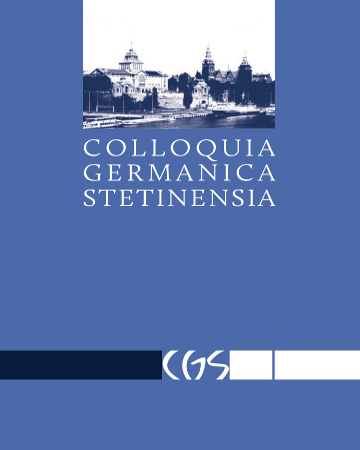







| Autorzy: |
Anna
Sulikowska

Wydział Humanistyczny, Instytut Językoznawstwa, US |
| Słowa kluczowe: | lingwistyka emocji złość metafora |
| Data publikacji całości: | 2020 |
| Liczba stron: | 15 (343-357) |
| Liczba pobrań ?: | 535 |
| 1. | Barcelona, Antonio. „Clarifying and applying the notions of metaphor and metonymy within cognitive linguistics: An update.“ In: Metaphor and Metonymy in Comparison and Contrast, hrsg. v. René Dirven, Pörings, Ralf, 207–278. Berlin, New York: Mouton de Gruyter, 2003. |
| 2. | Damasio, Antonio. Looking for Spinoza. Joy, Sorrow and the Feeling Brain. Orlando: A Harvest Book Harcourt, 2003. |
| 3. | Data, Krystyna. „W jaki sposób językoznawcy opisują emocje“. Acta Universitatis Wratislavienisis. Język a Kultura 14 (2000): 245–252. |
| 4. | Folkersma, Petra. Emotionen im Spannungsfeld zwischen Körper und Kultur. Frankfurt am Main, Berlin, Bern, Bruxelles, New York, Oxford, Wien: Peter Lang, 2010. |
| 5. | Fries, Norbert. „de ira“. Linguistik online 2003. Zugriff 20.10.2019. https://www.linguistik-online.net/13_01/ fries_a.html. |
| 6. | Fries, Norbert. Sprache und Emotionen. Ausführungen zum besseren Verständnis. Anregungen zum Nachdenken. Bergisch Galdbach: BLT, 2000. |
| 7. | Goosens, Louis. „Metaphtonymy. The interaction of metaphor and metonymy in expressions for linguistic action“. Cognitive Linguistics 1/3 (1990): 323–342. |
| 8. | Jäkel, Olaf. Metaphern in abstrakten Diskurs-Domänen: Eine kognitiv-linguistische Untersuchung anhand der Bereiche Geistestätigkeit, Wirtschaft und Wissenschaft. Frankfurt a. M.: Peter Lang, 1997. |
| 9. | Kövecses, Zoltan, Gary B. Palmer, René Dirven. „Language and emotion. The interplay of conceptualisation with physiology and culture“. In: Metaphor and Metonymy in Comparison and Contrast, hrsg. v. René Dirven, Ralf Pörings, 133–159. Berlin, New York: Mouton de Gruyter, 2003. |
| 10. | Kövecses, Zoltan. Metaphors of Anger, Pride, and Love. A lexical approach to the structure of concepts. Amsterdam, Philadelphia: John Benjamins, 1986. |
| 11. | Lakoff, George, Mark Johnson. Metaphors we live by. Chicago: University of Chicago Press, 1980. |
| 12. | Küpper, Heinz. Wörterbuch der deutschen Umgangssprache. Digitale Bibliothek 36. Directmedia Publishing, 2004. |
| 13. | Lakoff, George. Woman, fire and a dangerous things. What categories reveal about the mind? Chicago, London: The University of Chicago Press, 1986. |
| 14. | Lakoff, George, Zoltan Kövecses. „The cognitive model of anger inherent in American English“. In: Cultural Models in Language and Thought, hrsg. v. Dorothy Holland, Naomi Quinn, 195–221. Cambridge: Cambridge University Press, 1987. |
| 15. | Lakoff, George, Mark Johnson. Philosophy in the flesh: The embodied mind and its challenge to western thought. New York: Basic Books, 1999. |
| 16. | Laskowska, Elżbieta. „Uczucia w języku“. Annales Academiae Paedagogicae Cracoviensis. Studia Linguistica 19 (2004): 213–221. |
| 17. | Matsumoto, David, Hyi Sung Hwang. „Culture and Emotion: The Integration of Biological and Cultural Contributions“. Journal of Cross-Cultural Psychology 43 (2012): 91–118. |
| 18. | Mazurkiewicz-Sokołowska, Jolanta, Anna Sulikowska, Werner Westphal. Chancen und Perspektiven einer Emotionslinguistik. Hamburg: Dr. Kovač, 2016. |
| 19. | Mikołajczuk, Agnieszka. „Kognitywny obraz gniewu we współczesnej polszczyźnie“. Etnolingwistyka: problemy języka i kultury 8 (1996): 131-145. |
| 20. | Mikołajczuk, Agnieszka. Gniew we współczesnym języku polskim. Analiza semantyczna. Warszawa: Energeia, 1999. |
| 21. | Nowakowska-Kempna, Iwona. Konceptualizacja uczuć w języku polskim. T. II. Warszawa: WSP TWP, 2000. |
| 22. | Ortner, Heike. Text und Emotion. Theorie, Methode und Anwendungsbeispiele emotionslingusitischer Textanalyse. Tübingen: Narr, 2014. |
| 23. | Pfeiffer, Wolfgang. Etymologisches Wörterbuch des Deutschen. Koblenz: Edition Kramer, 2014. |
| 24. | Schwarz-Friesel, Monika. Sprache und Emotion. Tübingen, Basel: A. Francke, 2007. |
| 25. | Wierzbicka, Anna. Semantic Primitives. Frankfurt a. M.: Athäneum, 1972. |
| 26. | Ziem, Alexander. „Embodied emotions: TRAUER im Spannungsfeld von Sprache und Kognition“. In: Chancen und Perspektiven einer Emotionslinguistik, hrsg. v. Jolanta Mazurkiewicz-Sokołowska, Anna Sulikowska, Werner Westphal, 13–36. Hamburg: Dr. Kovač, 2016. |